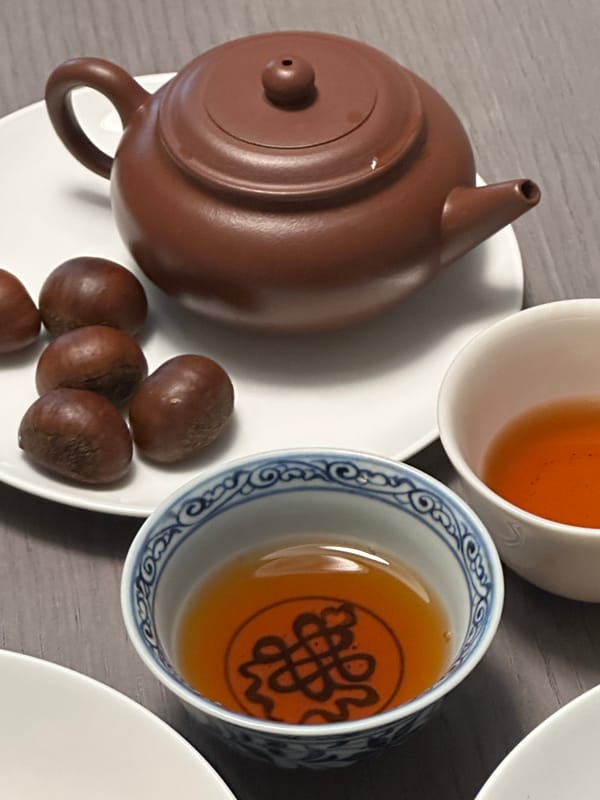The autumn breeze brushes softly against the window frame. Inside, the fragrance of tea rises slowly.
By the window, a cup of hot tea waits in silence. In your palm, a few chestnuts radiate warmth. Outside, the rustling of leaves continues. Inside, time feels nearly suspended.
A sip of tea, a bite of chestnut—the flavors merge, unhurried and gentle, like a reunion long-awaited since summer. Some flavors are simple, yet profoundly moving.
In Autumn’s Palm, Hold a Chestnut
Did you know that the steaming chestnuts from roadside stalls have been cultivated for over a thousand years? As early as the Western Zhou Dynasty, the Book of Songs recorded chestnut trees lining the roads. Chestnuts are not merely a seasonal snack—they are living artifacts, symbols of ancestral wisdom.
Today, there are four common types of chestnuts: Chinese chestnuts (Castanea mollissima), large Japanese chestnuts, uniquely flavored American chestnuts, and sweet European chestnuts often used for candied treats. Each has a distinct texture and flavor: Chinese chestnuts are sweet and easy to peel—great for roasting; Japanese chestnuts are aromatic but hard to skin; European chestnuts are renowned for their rich, creamy flesh.
Chestnuts aren’t just tasty—they’re nutritional powerhouses. Rich in carbohydrates, protein, and moderate fats, they’ve earned the nickname "King of Dry Fruits." A few chestnuts can replenish energy for undernourished children or elderly folks. Interestingly, chestnuts differ from most nuts—they’re actually starchy foods!
Tea and Chestnuts: Two Solitary Aromas Moving Closer
Why do some teas pair perfectly with chestnuts, while others mute their charm? It's not coincidence—it’s the fine art of flavor balance.
Newcomers to tea and chestnuts often reach for green tea or lightly oxidized oolong. But these teas, elegant yet delicate, often lack the presence to embrace the chestnut’s dense, mellow flavor—much like a violin’s soft melody drowned by the cello’s deep notes in a symphony.
On the other end, heavily fermented black teas or ripe pu-erh may come on too strong, overpowering the chestnut instead of conversing with it. It's like two strong personalities speaking at once—neither truly heard.
The Taste of Time: How Aged Oolong Understands Sweet Chestnuts
Years of tasting have taught me: aged oolong is the true soulmate of the chestnut.
Consider its character—after time’s refining touch, once-sharp tannins soften, and the roast transforms into a profound depth. One sip, and you taste a hint of bitterness, followed by a smooth, lingering sweetness. That depth resonates beautifully with the chestnut’s warm disposition.
Bite into a chestnut, and its soft sweetness unfurls slowly in the mouth.
Take a sip of aged oolong, and its subtle bitterness enhances the chestnut’s flavor—like starlight made brighter by the night. This seemingly paradoxical blend finds an exquisite balance on the palate. Time slows.
Tannins play a crucial role in this encounter. They awaken the chestnut’s restrained aroma, coaxing its sweetness into full bloom. The mild bitterness unfolds at the back of the tongue, the chestnut’s warmth spreading forward. In that moment, bitterness transforms into bliss—the unity of bitter and sweet that tea masters quietly pursue.
A Tea That Understands You—and Your Chestnuts
Pairing tea and chestnuts isn't just indulgence—it’s about finding calm and fulfillment. Slow down. Let the flavors open. Only then will you appreciate the nuanced harmony.
Start with a medium-roast oolong like Dong Ding. It’s understated but confident enough to engage the chestnut. Over time, venture into 3–5 year aged oolongs. With each year, the tea deepens—like an old friend who appreciates the chestnut without needing to speak.
Even the way you prepare chestnuts alters the dialogue. Steamed chestnuts whisper gently, ideal for medium-roast oolong. Roasted chestnuts speak louder—pair them with deeper-roast oolongs.
One tea, many expressions. Adjust the water temperature, steeping time, and tea leaves, and you’ll find variations—sometimes astringent, sometimes round as aged wine. Explore. Let the tea reveal which version best speaks to the chestnut’s soul.
Between Bitterness and Sweetness, We Simply Live
The union of tea and chestnuts, while simple on the surface, reflects the Eastern philosophy of balance. Like yin and yang, bitter and sweet do not cancel each other. They coexist—enhancing one another, crafting beauty through contrast.
Next time you hold a cup of aged oolong and a warm chestnut in your mouth, close your eyes.
Let your palate sense the dance between bitter and sweet.
In that merging of tea aroma and chestnut fragrance, you taste more than flavor—you experience a way of life. Finding balance in contradiction. Staying pure in complexity.
Whether you're a longtime tea companion or a curious first-timer, this encounter between chestnut and aged oolong is worth savoring slowly. It may become your cherished autumn memory—one the wind cannot blow away.


